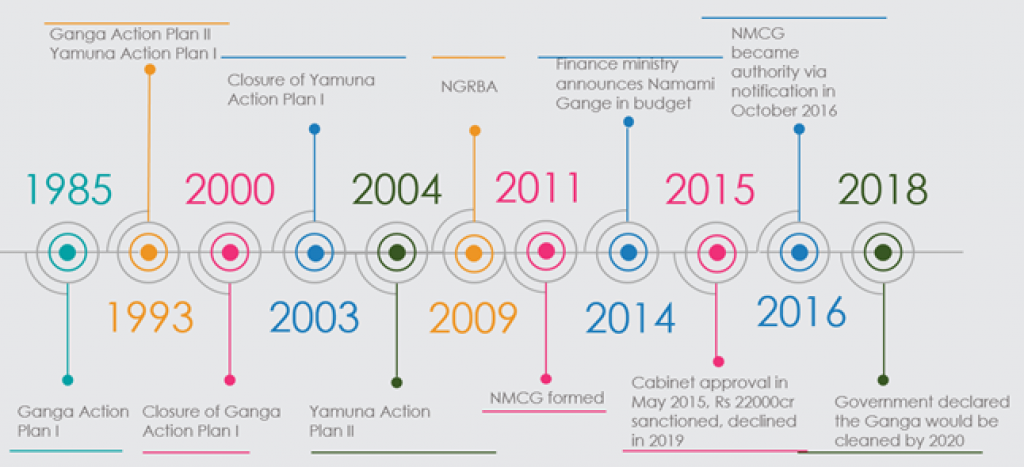Note4Students
From UPSC perspective, the following things are important :
Prelims level: BoD, CoD
Mains level: Namami Gange
The Ganga water quality has improved remarkably during the lockdown period. This highlights the importance of synergy for absolute symbiosis between nature and man as the need of the hour.
Context
- The novel coronavirus lockdown (COVID-19) pandemic has put millions in the throes of adversity — and yet, there is a reason to celebrate.
- Over a month into the nationwide lockdown, air and water pollution levels have shrunk and the wildlife is free.
- Of 36 monitoring units placed in the Ganga, water quality at 27 points was found suitable for bathing and propagation of wildlife and fisheries in the lockdown period
Status of rivers in India
- India’s water bodies are in a poor state. The rivers are becoming dumpyard for untreated sewage and industrial waste.
- In the name of economic growth, most rivers and streams have been turned into sewer canals and are getting difficult to be treated.
- It is estimated that every day, almost 40 million litres of wastewater enters rivers and other water bodies; only 37 per cent is adequately treated.
- A Centre Pollution Control Board (CPCB) report showed that critically polluted river stretches in the country have increased from 302 stretches in 2016 to 351 stretches in 2018.
- The finding was based on Biological Oxygen Demand (BOD).
Ganga

- According to CPCB, more than half of wastewater treatment plants in the basin do not comply with the discharge norms.
- Since 1985, several programmes and schemes have been launched to clean the Ganga. It began with the Ganga Action Plan I, followed by Ganga Action Plan II.

- In 2015, the biggest-ever initiative, Namami Gange was launched with a budget of over Rs 20,000.
- Despite numerous programmes and huge funds, the Ganga still runs polluted.
The causes
- More than 80 per cent of pollution in the Ganga is due to domestic sewage from surrounding towns and villages. The rest is contributed by industrial waste.
- During the lockdown, domestic sewage would have increased owing to increased demand for water to maintain hand-washing hygiene. Industrial waste, however, stopped entering the Ganga.
- Other activities such as tourism, fairs, bathing and cloth washing near the ghats were curtailed. Experts said these observations reflected that domestic sewerage was not the only cause of concern.
- When sewage is mixed with industrial effluents, it gets difficult for the river to assimilate pollution.
- One more reason was high number of western disturbances which brought rain and improved the flow in the river leading to dilution.
COVID-19’s gift to Ganga
- After the nationwide lockdown was imposed, within 10 days signs of improvement in water quality started surfacing.
- At Varanasi’s Nagwa Nala, the Dissolved Oxygen (DO) values were found increased to 6.8 milligram/litre against 3.8 mg/l on March 6, showcasing an extraordinary improvement of 79 per cent in DO values.
- 30 per cent of the total BOD load was due to industries along the river, which amounted to 130-150 tons per day.
- Since all major polluting industries are closed, the toxic load is off the river.
Surprisingly better
- Ganga water at Haridwar and Rishikesh was reported fit for drinking due to 500 per cent decrease in sewage and industrial effluents.
- A dip in the number of visitors at ghats in Haridwar also helped the river water quality.
- The Ganga water has become fit for ‘achaman’, which means ritual sipping, after a long time.
Bringing the ambitions to reality
There is an urgent need to:
- Reinvestigate the main source of pollution in Ganga and reorient all river cleaning policies and programmes based on lockdown findings.
- Industries need to strictly adhere to discharge norms accompanied with strong enforcement of laws and regulations vis-a-vis strong monitoring and vigilance framework.
- Setting up of effective interventions to clean rivers, reliable, representative and comprehensive data collected at high frequency in a disaggregated manner.
- There is an urgent need to expand the network of monitoring stations on the Ganga, the Yamuna and tributaries of Ganga in more places.
- Over-extraction and over-exploitation of Ganga’s waters have rendered long stretches of the river completely dry for much of the year. There is a need to maintain ecological flow to keep it clean for longer run.
- Education and awareness needs to be carried out strategically.
Back2Basics: Biochemical Oxygen Demand
- BOD is the amount of dissolved oxygen needed (i.e. demanded) by aerobic biological organisms to break down organic material present in a given water sample at certain temperature over a specific time period.
- The BOD value is most commonly expressed in milligrams of oxygen consumed per litre of sample during 5 days of incubation at 20 °C and is often used as a surrogate of the degree of organic pollution of water.
- BOD is similar in function to chemical oxygen demand (COD), in that both measure the amount of organic compounds in water.
- However, COD is less specific, since it measures everything that can be chemically oxidized, rather than just levels of biodegradable organic matter.
Get an IAS/IPS ranker as your 1: 1 personal mentor for UPSC 2024

